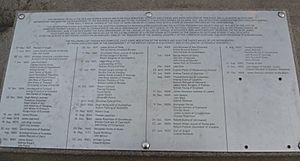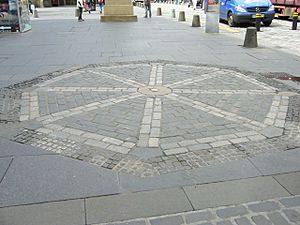William Govan facts for kids
Quick facts for kids
William Govan
|
|
|---|---|
| Born | 1623 |
| Died | 1 June 1661 (aged 38) Mercat Cross, Edinburgh, Kingdom of Scotland |
| Allegiance | Covenanters |
| Rank | Captain |
| Battles/wars | Scottish Civil War |
Captain William Govan (1623–1661) was a Scottish soldier. He fought for a group called the Covenanters during a time of big conflicts in Scotland, known as the Wars of the Three Kingdoms. In 1650, he was given the special job of showing Montrose's battle flag to the Scottish Parliament.
Later that same year, he was accused of leaving the Scottish army. People said he supported the English New Model Army, led by Oliver Cromwell, which was fighting in Scotland. On June 1, 1661, after the king returned to power, William Govan was found guilty of serious charges. He was put to death near the Mercat Cross in Edinburgh. His head was then displayed at West Port, Edinburgh.
Contents
Who Was William Govan?

William Govan was born in 1623. When he was about 14 years old, around 1637, he became very religious. He remained a strong follower of the Presbyterian faith for his whole life. Like many people in Scotland at that time, he supported important agreements called the National Covenant and the Solemn League. These agreements were about protecting the Presbyterian church in Scotland.
Govan's Role in the Wars
In 1650, William Govan was a captain in a cavalry (horse soldiers) group. This group was led by Colonel Archibald Strachan. Govan took part in the Battle of Carbisdale. In this battle, the Royalist general Montrose was defeated and captured. After the battle, Govan had the honor of carrying Montrose's battle flag through the streets of Edinburgh. He then delivered it to the Scottish Parliament.
Challenges and Accusations
Colonel Strachan, Govan's leader, had very strong opinions. He and two other officers, including Govan (who was now a major), had discussions with Oliver Cromwell and his officers. Strachan did not agree with some Scottish leaders who wanted to fight against Charles II. He believed that if the Scots rejected Charles II as king, the English army might leave Scotland.
Because of his views, Strachan was removed from his command. Govan and another officer were also dismissed from the army. Strachan at first did not want to give up his command. When he finally did, he stayed close to his soldiers. Another leader, Gilbert Ker, then took charge of the army.
The Battle of Hamilton
Gilbert Ker allowed Govan to rejoin the army. Govan promised to fight for Ker. Ker decided to attack the English soldiers stationed in Hamilton. However, he did not know that a large group of English horse soldiers had arrived. The attack was meant to be a surprise at dawn. But the English were ready and waiting.
The Battle of Hamilton was a disaster for the Scots. Ker was wounded, and Govan and others were captured. The remaining Scottish soldiers scattered. However, Strachan and about thirty others decided to join the English Parliamentary army. For his actions during the Hamilton events, Strachan was found guilty of serious charges. He lost his property and was removed from the church. He passed away the next year in 1652.
Trial and Execution
When the king returned to power in Scotland, William Govan was put on trial. The charges against him were from 1651. He was found guilty of leaving the Scottish army and supporting the English army.
There were also rumors that he had warned the English about the Scottish attack on Hamilton. Another rumor said he was present when King Charles I was put to death. The first rumor was never proven. Govan denied the second rumor in a public speech he made before his execution. In that same speech, he also denied that he had joined the English in 1650. He said he was a prisoner of war captured at Hamilton.
William Govan was put to death near the Mercat Cross in Edinburgh. This happened shortly after another person, James Guthrie, on June 1, 1661. After he passed away, his head was removed and displayed on a spike at the West Port of Edinburgh.
Family Life
William Govan was a married man. Just before he was put to death, he gave a ring from his finger to a friend. He asked his friend to give the ring to his wife.
Images for kids




